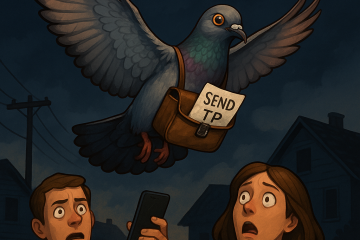
How to train pigeons to deliver messages
So you’ve read about pigeons being the ultimate low-tech communication system and thought, “Sure, why not? I’ll build my own flying Verizon network.” Great news: training pigeons is less complicated than programming your TV remote. (And let’s be honest, who really knows how to use all those buttons?)
Below is your quick-and-coo guide to turning a humble flock into a dependable communication crew.
Step 1: Build Them a Loft (a.k.a. Bird B&B)
Pigeons aren’t picky, but they do need a home base. A loft is basically a glorified birdhouse with room to roost, nest, and feel safe. Think of it as their Wi-Fi router—it’s where they’ll always return, no matter where you launch them.
-
Location: Elevated and sheltered, away from predators.
-
Size: About 4 cubic feet per bird is plenty.
-
Features: Perches, ventilation, and a trapdoor so you can let them out but they can’t sneak in without your permission. (Think nightclub bouncer, but feather-friendly.)
Step 2: Bond Them to the Loft
The secret to homing pigeons is that they’re obsessed with their “home address.” To build this loyalty:
-
Keep them inside their loft for the first 4–6 weeks so they imprint on it.
-
Feed and water them there exclusively. If the loft feels like the all-inclusive resort of their dreams, they’ll never ghost you.
Step 3: Start Short Flights
Once they’re attached to the loft like kids to Wi-Fi, it’s time to stretch their wings:
-
Begin by letting them fly free around the loft. They’ll do circles like tiny feathered drones, memorizing landmarks.
-
After a week of “home tours,” start taking them a quarter mile away and releasing them. Slowly increase the distance: a mile, three miles, five miles.
-
Pro tip: Always release them hungry, and then feed them back at the loft. Nothing motivates like dinner waiting at home.
Step 4: Teach Two-Way Messaging
Here’s the catch: pigeons only fly home. So, if you want to communicate with your buddy Carl three towns over, Carl has to keep his pigeons at your place. Then when you need to send him a note, you release one of Carl’s pigeons—it’ll head straight home to him. If Carl wants to reply, he’ll release one of your pigeons from his place. Voilà: low-tech texting.
Step 5: Keep Them Healthy and Happy
Healthy pigeons = reliable pigeons. Feed them a grain mix (wheat, corn, millet, peas), provide grit for digestion, and keep fresh water in the loft. A little apple cider vinegar in their water once a week helps keep parasites at bay. Cost? Around $15–$30 a month for a small flock.
And yes, pigeons pull double duty—communication AND cuisine. Young pigeons, called squab, have been considered gourmet for centuries. Translation: if your messages stop arriving, check your neighbor’s dinner plate.
Step 6: Train for Distance and Endurance
With time, you can stretch your pigeons’ range to 50, 100, even 300 miles. Military homing pigeons in WWII regularly flew hundreds of miles with critical intel strapped to their legs. If they could carry life-or-death messages through bullets and bombs, yours can definitely carry “Bring chocolate ASAP.”
Why This Matters
Prepping isn’t about building bunkers with motion-sensing shark moats (though admit it, you thought about it). It’s about using clever, old-school methods that keep you connected when modern systems fail. Training pigeons is equal parts practical skill, quirky hobby, and hilarious icebreaker.
So go ahead—start your loft. Because when the blackout hits and everyone else is fighting over the last solar charger, you’ll be tying a note to a bird and saying:
“Fly, my little postman, fly.”

